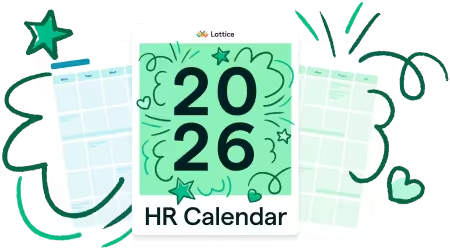Temporary Disability Policy Template

.webp)
Download this template for free
By submitting your information, you agree to Lattice's Terms of Service and Privacy Policy. You can opt out anytime.
Thanks! We'll be in touch soon.
Temporary disabilities — from a broken limb to post-surgery recovery to mental health conditions — can impact an employee’s ability to perform their job duties for a limited time. A Temporary Disability Policy helps companies support their people through these challenges while ensuring clear processes and expectations are in place for both employees and managers.
This policy is more than a compliance document — it’s a tangible reflection of how your company prioritizes employee well-being and inclusivity. Done right, it supports a culture of trust, transparency, and accessibility, offering peace of mind to employees who may be navigating stressful health-related challenges.
What a Temporary Disability Policy Should Include
To be both compliant and compassionate, a strong Temporary Disability Policy should cover:
- Eligibility criteria: Define who qualifies for temporary disability leave and under what circumstances.
- Definition of temporary disability: Clarify what counts as a temporary disability — physical or mental impairments that substantially limit one or more major life activities for a limited period.
- Process for requesting leave: Outline how employees should notify HR or their manager, documentation required, and timeframes for submission.
- Medical certification: Explain what kind of documentation is needed from healthcare providers and how often it must be updated.
- Leave duration: Specify how much leave is available, whether it runs concurrently with other types of leave (e.g., FMLA), and under what conditions it can be extended.
- Pay and benefits during leave: State whether the leave is paid or unpaid, and whether employees can use PTO or short-term disability insurance.
- Job protection and return-to-work procedures: Outline if and how the employee’s position is protected, the process for returning to work, and any required medical clearance.
- Accommodation procedures: Describe the process for requesting and evaluating accommodations (e.g., modified duties, remote work).
- Confidentiality: Reassure employees that their health information will be kept confidential and shared only on a need-to-know basis.
- Compliance with legal standards: Reference relevant federal, state, or local laws (e.g., Americans with Disabilities Act (ADA), Family and Medical Leave Act (FMLA)).
Purpose of This Policy
The Temporary Disability Policy exists to:
- Support employees through temporary health-related challenges by offering clear procedures, accommodations, and job protections.
- Promote fairness and consistency in how temporary disabilities are addressed across teams and departments.
- Ensure compliance with relevant labor and disability laws, such as the ADA and FMLA.
- Uphold the company’s values of inclusion, dignity, and empathy by providing a respectful and legally compliant process for employees managing temporary health issues.
Temporary Disability Policy Template
{{rich-highlight-1}}
1. Policy Overview
This policy outlines [Company Name]’s commitment to supporting employees who experience a temporary disability that affects their ability to perform their job duties. Our goal is to provide a process that ensures consistency, legal compliance, and care for employees navigating health-related challenges.
2. Eligibility
Employees are eligible for temporary disability leave if they:
- Are experiencing a temporary physical or mental health condition that substantially limits one or more major life activities.
- Provide appropriate medical documentation from a licensed healthcare provider verifying the condition and anticipated recovery period.
- Have completed at least [X months] of continuous employment (if applicable to your company or jurisdiction).
This policy applies to both full-time and part-time employees unless otherwise stated.
3. Definition of Temporary Disability
A temporary disability is defined as any non-permanent physical or mental impairment that limits an individual’s ability to perform essential job functions for a limited period of time. Examples include, but are not limited to:
- Recovery from surgery
- Short-term mental health conditions (e.g., acute anxiety, depression)
- Injuries such as fractures, sprains, or torn ligaments
- Pregnancy-related conditions or recovery post-delivery (separate from maternity leave, if applicable)
4. Requesting Temporary Disability Leave
Employees should notify their manager or HR as soon as they become aware of the need for temporary disability leave. Requests should include:
- A completed leave request form
- A medical certification from a licensed healthcare provider stating:
- The nature of the condition (general description, not diagnosis)
- Anticipated start and end date of leave
- Recommendations for accommodations (if applicable)
If the condition is sudden or unforeseen (e.g., injury), employees should notify HR as soon as is reasonably possible.
5. Medical Certification Requirements
A signed letter from a licensed healthcare provider must accompany the leave request. The company reserves the right to request:
- Periodic updates from the employee’s provider (e.g., monthly)
- Independent medical evaluation (at the company’s expense) in certain cases
- Return-to-work clearance from a healthcare provider prior to reinstatement
6. Duration of Leave
The duration of leave is determined on a case-by-case basis and depends on:
- Medical documentation provided
- Applicable laws (e.g., up to 12 weeks under FMLA, if eligible)
- Availability of PTO or short-term disability insurance
Employees may request an extension if medically necessary, but must submit updated documentation no later than five business days before the original leave ends.
7. Pay and Benefits During Leave
- Leave may be paid or unpaid, depending on the nature of the disability and availability of:
- Accrued paid time off (PTO)
- Short-term disability benefits (if enrolled)
- State disability insurance (where applicable)
- Employees may be required to use accrued PTO before accessing unpaid leave or short-term disability coverage.
- Health benefits (e.g., medical, dental, vision) will continue during approved leave, although employees may be required to continue premium contributions.
8. Job Protection and Reinstatement
- If leave qualifies under FMLA or a state leave law, job protection will apply per statutory requirements.
- Upon return from approved leave, employees will be reinstated to their same position or an equivalent one, provided they can perform essential job functions, with or without accommodations.
- If job restoration is not possible due to business needs, the company will engage in an interactive process to explore other options.
9. Accommodations and Modified Duties
If an employee is able to return to work with restrictions, [Company Name] will:
- Engage in an interactive process with the employee and their healthcare provider
- Explore reasonable accommodations such as:
- Modified work schedules
- Alternative work duties
- Temporary remote work
- Assistive devices or ergonomic adjustments
Accommodations will be evaluated on a case-by-case basis and implemented where feasible without undue hardship to the business.
10. Confidentiality
All employee medical records and documentation related to temporary disability will be kept confidential and stored separately from personnel files. Information will only be shared with individuals who need it to facilitate the accommodation or leave process.
{{rich-highlight-3}}
11. Compliance and Coordination With Other Leave Policies
This policy complies with applicable federal, state, and local laws, including but not limited to:
- Americans with Disabilities Act (ADA)
- Family and Medical Leave Act (FMLA)
- State-specific disability insurance programs (e.g., CA SDI, NY DBL)
This policy is intended to complement, not replace, any other company policies governing leaves of absence.
Frequently Asked Questions
Who determines if a condition qualifies as a temporary disability?
A licensed medical professional provides certification, but the final determination is made by HR based on documentation, job requirements, and legal guidelines.
Can I take temporary disability leave intermittently?
Yes, intermittent leave may be granted if medically necessary and supported by documentation. This could include reduced work hours or periodic absences.
Will I still get paid while on leave?
That depends on whether you have accrued PTO, are enrolled in short-term disability benefits, or are eligible for state disability insurance. HR can walk you through your options.
What happens if I can’t return to work when expected?
If your condition extends beyond the anticipated recovery period, you’ll need to submit updated medical documentation. HR will assess whether an extension can be granted or explore other options like long-term disability or accommodation.
What if my job can’t be held while I’m out?
In most cases, your job (or an equivalent role) will be held for you, particularly if your leave is protected under FMLA or ADA. If job restoration isn’t feasible, the company will engage in a good-faith effort to find suitable alternatives.
{{rich-highlight-2}}
🚩 Please note: This sample policy is for informational purposes only and does not constitute legal advice. It is a generic template that may not suit your specific circumstances. When adopting or revising a policy, consult legal counsel to ensure compliance with all applicable laws and regulations.
✨ Disclaimer: This resource was developed with the help of artificial intelligence, though reviewed, edited, and approved by (real) humans.
Frequently Asked Questions

Your people are your business
Ensure both are successful with Lattice.





